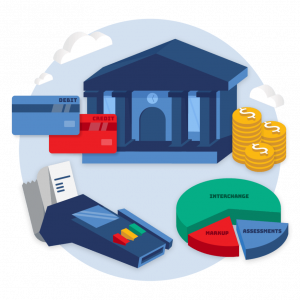Flat Rate Credit Card Processing
Is Flat Rate Pricing Right for Your Small Business?
This page explains flat rate credit card processing because we think every small business needs to know how it works and the rare merchants it’s good for. But you’ll shortly find that we aren’t big fans of flat rate pricing and hardly ever recommend it to our clients.
Why? Because flat rate credit card processing isn’t designed to save your business money—it’s just designed to be simple. Such simplicity, at least in the credit card payment industry, is almost always a covert way to charge more.

Flat Rate Processing:
What You'll Discover Below
Payment Processing 101
Flat-rate processing offers merchants simplicity but at typically a higher cost. Understanding flat-rate processing can help you determine whether or not it’s the pricing structure for your business.
Want to know more about payment processing as a business owner? Click the button below to access our paymentprocessing guide.
What is Flat Rate Pricing?
Flat rate pricing is a pricing structure that applies a simple flat rate to every card transactions. Typically, this involves at least two rates: a lower flat rate for card-present transactions and a higher flat rate for card-not-present transactions.
So, if you accept a payment in person and your customer swipes or chips their card, you’ll pay a lower fee. If you key-in the card information manually or receive the payment through a website, you’ll pay a higher fee. It’s that simple.
Who Offers Flat Rate Pricing?
The companies best known for flat rate pricing are payment aggregators like Square, PayPal and Stripe. Aggregators process payments for multiple businesses through the same merchant accounts (often called aggregated merchant accounts), which allows merchants to bypass the need to get a dedicated merchant account with an acquiring bank.
Some traditional payment processors, however, also offer flat rate pricing as an option for some merchants—they just tend not to advertise it because it isn’t their primary vehicle for pricing merchants. In such cases, your business would still have a dedicated merchant account, but your pricing would follow the flat rate model.
What is the Typical Flat Rate?
Flat rates for credit card processing typically fall within the range of 2-4% of your sales.
Just keep in mind that not all providers set their flat rates in the same way. Some will charge a fixed fee on volume and nothing else (for example, 2.9%), while others will charge a per-volume fee and a per-item fee—such as 2.6% + $0.10.
In any case, the rates will be consistent. If you know your rates, the percentage of your sales that are card-present vs. card-not-present, and your average monthly sales, it’s easy to project your processing costs each month—a big reason so many merchants find flat rate pricing plans so attractive.
Flat Rate Pricing & Processing Fees
Credit card processing companies that offer flat rate pricing determine their rates based on their wholesale costs, which means a lot of complexity lies behind those apparently simple flat fees.
In general, these wholesale costs include interchange fees and assessment fees (also called card brand fees), both set by the credit card networks like Visa and MasterCard.
Since no processor or provider has any control over these fees and simply has to pay them, and since interchange rates in particular go up or down depending on a range of factors, the rates for any flat rate pricing plan have to be set high enough to cover these fluctuating costs.
The result? Merchants are likely to pay more for individual transactions on a flat rate pricing plan than on a more competitive pricing structure like interchange plus pricing. We’ll explain why in the section below.
Flat Rate vs. Interchange Plus Pricing
Flat rate processing is only one of several common credit card pricing models or structures (the others being tiered pricing and interchange plus pricing).
Tiered pricing is awful generally, so we won’t bother contrasting it with flat rate pricing here, but interchange plus pricing is a different story entirely. Here’s why:
- Flat rate pricing takes all of the provider’s wholesale costs and bundles them together.
- Interchange plus pricing, by contrast, passes the processor’s wholesale costs directly to the merchant, and then the processor adds its markups and other service fees on top of that.
Essentially, this means that merchants on interchange plus pricing plans save money when the wholesale costs for transactions—the interchange fees and card brand fees—are lower. Why? Because with interchange plus pricing the merchant pays the wholesale costs, and the processor’s markup stays the same.
With flat rate pricing, the provider pockets any savings on transactions that have lower interchange rates because your flat rates don’t change. That’s why we called flat rate pricing a covert way to charge you more. It trades cost-effectiveness for simplicity.
Related: Credit Card Pricing Structures
Who is Flat Rate Pricing Good For?
If flat rate pricing is usually expensive, why would any merchant sign up for a flat rate pricing plan? Sometimes the merchant isn’t experienced enough to know any better, but there are cases where flat rate pricing, regardless of its costs, can still make good sense for individual merchants.
In our experience, these situations break down into at least 5 types:
It’s undeniably easier to understand flat rate pricing than it is to understand interchange plus pricing (with its merchant statements riddled with obscure fee names and complex tables), and some merchants just prefer that simplicity and don’t mind the added costs.
The underwriting process for signing up with a payment aggregator is virtually nonexistent, so it’s much easier to start accepting payments through an aggregator than through a payment processor or traditional merchant account provider. If time is of the essence, and you don’t mind the potential high costs of a flat rate pricing plan, signing up with a payment aggregator might be right for you.
Interchange plus pricing requires a dedicated merchant account with an acquiring bank, and that means your processor will examine your business’s history, finances, and your personal credit before approving your account. If you’re a brand new business, have a poor credit history, or have a prior processing history that includes a ratio of credit card chargebacks, your business might not qualify for a merchant account at all.
Though interchange plus pricing is typically cheaper than flat rate pricing for most merchants, that isn’t always true. There are monthly costs associated with most traditional merchant accounts and interchange plus pricing plans, so if you aren’t generating enough revenue to absorb those costs, the money you would save on lower rates won’t make much of a difference in the end.
If your business’s average ticket is fairly low (think small coffee shops or small used bookstores), you could save money with flat rate pricing if your provider doesn’t charge a per-item fee on transactions (just a flat percentage rate instead). Interchange plus pricing plans pretty much always include a per-item fee of some kind—fees that add up fast if you’re processing a high number of low-ticket transactions. Note, however, that aggregators using flat rate pricing often include both a percentage rate and a per-item fee as well.
Ultimately, of course, the decision to pursue a flat rate pricing plan comes down to the services you need and the rates your business can afford.
We aren’t enemies of flat rate pricing, and there are even rare occasions when a merchant’s average ticket size or other factors lead us to recommend a flat rate pricing model over interchange plus. It just isn’t common for us because we find most of our clients will save more money, at least in the long run, when they sign up for a competitive interchange plus pricing plan.
Related: Interchange Plus Pricing





